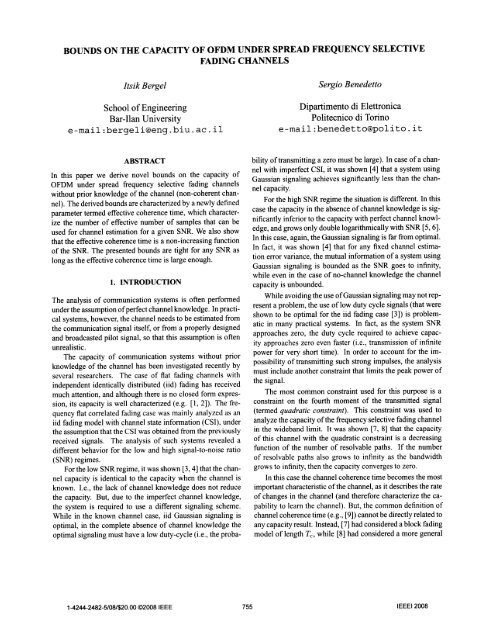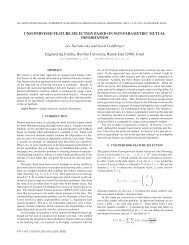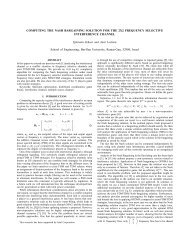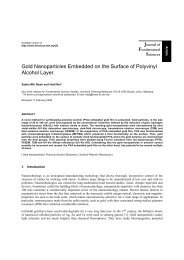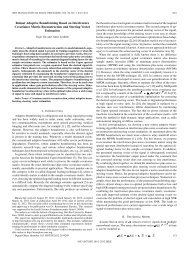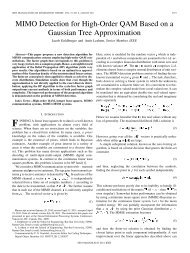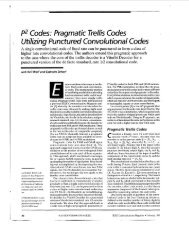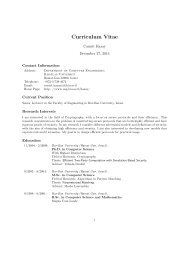bounds on the capacity of ofdm under spread ... - IEEE Xplore
bounds on the capacity of ofdm under spread ... - IEEE Xplore
bounds on the capacity of ofdm under spread ... - IEEE Xplore
You also want an ePaper? Increase the reach of your titles
YUMPU automatically turns print PDFs into web optimized ePapers that Google loves.
BOUNDS ON THE CAPACITY OF OFDM UNDER SPREAD FREQUENCY SELECTIVEFADING CHANNELSItsik BergelSchool <strong>of</strong>EngineeringBar-Ilan Universitye-mail:bergeli@eng.biu.ac.ilSergio BenedettoDipartimento di Elettr<strong>on</strong>icaPolitecnico di Torinoe-mail:benedetto@polito.itABSTRACTIn this paper we derive novel <str<strong>on</strong>g>bounds</str<strong>on</strong>g> <strong>on</strong> <strong>the</strong> <strong>capacity</strong> <strong>of</strong>OFDM <strong>under</strong> <strong>spread</strong> frequency selective fading channelswithout prior knowledge <strong>of</strong> <strong>the</strong> channel (n<strong>on</strong>-coherent channel).The derived <str<strong>on</strong>g>bounds</str<strong>on</strong>g> are characterized by a newly definedparameter termed effective coherence time, which characterize<strong>the</strong> number <strong>of</strong> effective number <strong>of</strong> samples that can beused for channel estimati<strong>on</strong> for a given SNR. We also showthat <strong>the</strong> effective coherence time is a n<strong>on</strong>-increasing functi<strong>on</strong><strong>of</strong> <strong>the</strong> SNR. The presented <str<strong>on</strong>g>bounds</str<strong>on</strong>g> are tight for any SNR asl<strong>on</strong>g as <strong>the</strong> effective coherence time is large enough.1. INTRODUCTIONThe analysis <strong>of</strong> communicati<strong>on</strong> systems is <strong>of</strong>ten performed<strong>under</strong> <strong>the</strong> assumpti<strong>on</strong> <strong>of</strong>perfect channel knowledge. In practicalsystems, however, <strong>the</strong> channel needs to be estimated from<strong>the</strong> communicati<strong>on</strong> signal itself, or from a properly designedand broadcasted pilot signal, so that this assumpti<strong>on</strong> is <strong>of</strong>tenunrealistic.The <strong>capacity</strong> <strong>of</strong> communicati<strong>on</strong> systems without priorknowledge <strong>of</strong> <strong>the</strong> channel has been investigated recently byseveral researchers. The case <strong>of</strong> flat fading channels withindependent identically distributed (iid) fading has receivedmuch attenti<strong>on</strong>, and although <strong>the</strong>re is no closed form expressi<strong>on</strong>,its <strong>capacity</strong> is well characterized (e.g. [1, 2]). The frequencyflat correlated fading case was mainly analyzed as aniid fading model with channel state informati<strong>on</strong> (CSI), <strong>under</strong><strong>the</strong> assumpti<strong>on</strong> that <strong>the</strong> CSI was obtained from <strong>the</strong> previouslyreceived signals. The analysis <strong>of</strong> such systems revealed adifferent behavior for <strong>the</strong> low and high signal-to-noise ratio(SNR) regimes.For <strong>the</strong> low SNR regime, it was shown [3,4] that <strong>the</strong> channel<strong>capacity</strong> is identical to <strong>the</strong> <strong>capacity</strong> when <strong>the</strong> channel isknown. I.e., <strong>the</strong> lack <strong>of</strong> channel knowledge does not reduce<strong>the</strong> <strong>capacity</strong>. But, due to <strong>the</strong> imperfect channel knowledge,<strong>the</strong> system is required to use a different signaling scheme.While in <strong>the</strong> known channel case, iid Gaussian signaling isoptimal, in <strong>the</strong> complete absence <strong>of</strong> channel knowledge <strong>the</strong>optimal signaling must have a low duty-cycle (i.e., <strong>the</strong> proba-bility <strong>of</strong>transmitting a zero must be large). In case <strong>of</strong>a channelwith imperfect CSI, it was shown [4] that a system usingGaussian signaling achieves significantly less than <strong>the</strong> channel<strong>capacity</strong>.For <strong>the</strong> high SNR regime <strong>the</strong> situati<strong>on</strong> is different. In thiscase <strong>the</strong> <strong>capacity</strong> in <strong>the</strong> absence <strong>of</strong>channel knowledge is significantlyinferior to <strong>the</strong> <strong>capacity</strong> with perfect channel knowledge,and grows <strong>on</strong>ly double logarithmically with SNR [5, 6].In this case, again, <strong>the</strong> Gaussian signaling is far from optimal.In fact, it was shown [4] that for any fixed channel estimati<strong>on</strong>error variance, <strong>the</strong> mutual informati<strong>on</strong> <strong>of</strong>a system usingGaussian signaling is bounded as <strong>the</strong> SNR goes to infinity,while even in <strong>the</strong> case <strong>of</strong> no-channel knowledge <strong>the</strong> channel<strong>capacity</strong> is unbounded.While avoiding <strong>the</strong> use <strong>of</strong>Gaussian signaling may not representa problem, <strong>the</strong> use <strong>of</strong>low duty cycle signals (that wereshown to be optimal for <strong>the</strong> iid fading case [3]) is problematicin many practical systems. In fact, as <strong>the</strong> system SNRapproaches zero, <strong>the</strong> duty cycle required to achieve <strong>capacity</strong>approaches zero even faster (i.e., transmissi<strong>on</strong> <strong>of</strong> infinitepower for very short time). In order to account for <strong>the</strong> impossibility<strong>of</strong>transmitting such str<strong>on</strong>g impulses, <strong>the</strong> analysismust include ano<strong>the</strong>r c<strong>on</strong>straint that limits <strong>the</strong> peak power <strong>of</strong><strong>the</strong> signal.The most comm<strong>on</strong> c<strong>on</strong>straint used for this purpose is ac<strong>on</strong>straint <strong>on</strong> <strong>the</strong> fourth moment <strong>of</strong> <strong>the</strong> transmitted signal(termed quadratic c<strong>on</strong>straint). This c<strong>on</strong>straint was used toanalyze <strong>the</strong> <strong>capacity</strong> <strong>of</strong><strong>the</strong> frequency selective fading channelin <strong>the</strong> wideband limit. It was shown [7, 8] that <strong>the</strong> <strong>capacity</strong><strong>of</strong> this channel with <strong>the</strong> quadratic c<strong>on</strong>straint is a decreasingfuncti<strong>on</strong> <strong>of</strong> <strong>the</strong> number <strong>of</strong> resolvable paths. If <strong>the</strong> number<strong>of</strong> resolvable paths also grows to infinity as <strong>the</strong> bandwidthgrows to infinity, <strong>the</strong>n <strong>the</strong> <strong>capacity</strong> c<strong>on</strong>verges to zero.In this case <strong>the</strong> channel coherence time becomes <strong>the</strong> mostimportant characteristic <strong>of</strong><strong>the</strong> channel, as it describes <strong>the</strong> rate<strong>of</strong> changes in <strong>the</strong> channel (and <strong>the</strong>refore characterize <strong>the</strong> capabilityto learn <strong>the</strong> channel). But, <strong>the</strong> comm<strong>on</strong> definiti<strong>on</strong> <strong>of</strong>channel coherence time (e.g., [9]) cannot be directly related toany <strong>capacity</strong> result. Instead, [7] had c<strong>on</strong>sidered a block fadingmodel <strong>of</strong> length T c , while [8] had c<strong>on</strong>sidered a more general1-4244-2482-5/08/$20.00 ©2008 <strong>IEEE</strong> 755 <strong>IEEE</strong>I2008
model and gave a novel definiti<strong>on</strong> for <strong>the</strong> channel coherencetime that is directly c<strong>on</strong>nected to <strong>the</strong> channel <strong>capacity</strong>.But, this definiti<strong>on</strong> <strong>of</strong>channel coherence time ([8]) is <strong>on</strong>lyeffective for infinite bandwidth (or equivalently at <strong>the</strong> lowSNR limit). In this paper we extend this definiti<strong>on</strong>, and showthat <strong>the</strong> novel definiti<strong>on</strong> is applicable for finite bandwidth andanySNR.In this paper we represent <strong>the</strong> finite bandwidth <strong>under</strong><strong>spread</strong>channel by an OFOM <strong>under</strong>-<strong>spread</strong> channel andpresent novel <str<strong>on</strong>g>bounds</str<strong>on</strong>g> <strong>on</strong> <strong>the</strong> channel <strong>capacity</strong>. This <str<strong>on</strong>g>bounds</str<strong>on</strong>g>are characterized by a newly defined parameter termed effectivecoherence time. The novel lower and upper <str<strong>on</strong>g>bounds</str<strong>on</strong>g>derived in this paper are tight enough to characterize <strong>the</strong>channel <strong>capacity</strong> as l<strong>on</strong>g as <strong>the</strong> effective coherence time islarge enough.2.1. Channel model2. SYSTEM MODELWe use <strong>the</strong> OFOM model [10], in which <strong>the</strong> Fourier transform<strong>of</strong><strong>the</strong> received signal is given by:- 6. t - 6. twhere X k = F X k and H k = F H k are <strong>the</strong> Fourier transforms<strong>of</strong><strong>the</strong> input vector and channel impulse resp<strong>on</strong>se at <strong>the</strong>k-th symbol respectively. Both are vectors <strong>of</strong> length N, andeach input vector is also termed OFOM symbol. F denotes<strong>the</strong> OFT matrix with elements:F= _1_e-2j1rmn/Nm,n VN .The frequency domain noise Wk ~ FtWk is a zero meancomplex Gaussian vector with covariance matrix: Cw = I.The multiplicati<strong>on</strong> by VN follows from <strong>the</strong> definiti<strong>on</strong> <strong>of</strong> <strong>the</strong>Fourier analysis matrix, (2).The channel itself is better characterized in <strong>the</strong> time domainwhere H k= [h k0' ... ,h k £_1,0, ... ,O]T, and L istermed <strong>the</strong> channel memory length. We assume a wide sensestati<strong>on</strong>ary Gaussian channel, with uncorrelated scattering(WSSUS channel). The stacking <strong>of</strong> <strong>the</strong> channel vector hasa complex Gaussian distributi<strong>on</strong>, H~ rv CN(E[H~],CHk),and <strong>the</strong> covariance matrix <strong>of</strong> <strong>the</strong> channel (in time domain)can be written as:where C~ is a (k + 1) x (k + 1) Toeplitz matrix defined by(Ckh)l m = C h h jC h , CH is an N x N diag<strong>on</strong>al, O,lN' OzmN 0,0 0matrix and ® symbolIzes <strong>the</strong> Kr<strong>on</strong>ecker product. For normalizati<strong>on</strong>purposes we will use Tr[CH ] o= 1. We also define <strong>the</strong>k x 1 vector c~ in which (C~)l = (C~)l,k, l = 0, ... , k - 1.This vector is <strong>the</strong> correlati<strong>on</strong> between <strong>the</strong> channel tap valueat <strong>the</strong> k-th symbol and its value at all previous symbols. The(2)(3)vector will be used in <strong>the</strong> analysis <strong>of</strong> <strong>the</strong> channel estimati<strong>on</strong><strong>of</strong><strong>the</strong> k-th symbol. We also assume that at most <strong>on</strong>e channeltap has an expectati<strong>on</strong> different from zero.The input signal has c<strong>on</strong>straints <strong>on</strong> <strong>the</strong> first and sec<strong>on</strong>dmoments <strong>of</strong><strong>the</strong> symbol power:E[X!X k ] ~ Npx, E[(X!X k )2] ~ aN 2 p;. (4)where a ~ 1 is termed <strong>the</strong> quadratic c<strong>on</strong>straint c<strong>on</strong>stant.In <strong>the</strong> journal versi<strong>on</strong> <strong>of</strong> this paper we also c<strong>on</strong>sider a peakpower c<strong>on</strong>straint and <strong>the</strong> case in which <strong>the</strong> transmitted symbolsare required to be statistically independent. In this workwe do not allow any feedback, and <strong>the</strong>refore we assume that<strong>the</strong> input symbols are statistically independent <strong>of</strong><strong>the</strong> channel.3. CHANNEL CAPACITY AND BOUNDSAs <strong>the</strong> channel <strong>capacity</strong> is not known, in <strong>the</strong> following wepresent tight lower and upper <str<strong>on</strong>g>bounds</str<strong>on</strong>g> <strong>on</strong> it. Due to <strong>the</strong> spacelimitati<strong>on</strong>s, some results are stated without pro<strong>of</strong>.Theorem 1 The <strong>capacity</strong><strong>of</strong><strong>the</strong> channel is upperboundedby:UBI = max E1:s;,a:S;QC ~ min (LB 1 ,LB 2 ) (5)LB I = EfI o[lOg (NPxlho,oI2 + 1)]2LB = N IE [fi ]1ap;(T c - N) aNp;2 px n,O + 1 + Px eTc _ N) + 2where T c is <strong>the</strong> effective coherence time given in (7).Pro<strong>of</strong><strong>of</strong>Theorem 1 is given in <strong>the</strong> journal versi<strong>on</strong> <strong>of</strong>thispaper [11}.Note that LB 1 is <strong>the</strong> complete CSI bound and is dominantin high SNRs, while LB 2 takes into account <strong>the</strong> uncertaintydue to <strong>the</strong> missing CSI, and is dominant for lower SNRs.Theorem 2 The <strong>capacity</strong> <strong>of</strong><strong>the</strong> channel is lower boundedby:IN(3E [fi ]+ 1.. pxrrc-N) Zl2n,ON Px(Tc-N)+£UB2 ~ E log 1 + 1 L-Np-x + -N-Px-(""'lC"'Tc---N-)-+-N-Lwhere z rv CN(O, 1) is a standard complex normal randomvariable, and CQ(p) is <strong>the</strong> achievable mutual informati<strong>on</strong>forQPSKtransmissi<strong>on</strong> overAWGNchannel with SNR equal to p,evaluated in [12}.(6)1-4244-2482-5/08/$20.00 ©2008 <strong>IEEE</strong> 756 <strong>IEEE</strong>I2008
Pro<strong>of</strong><strong>of</strong> Theorem 2 is given in <strong>the</strong> journal versi<strong>on</strong> <strong>of</strong> thispaper [iil.Note that UBI is achieved using narrowband QPSK transmissi<strong>on</strong>with duty cycle <strong>of</strong> j3, and is tight for low SNRs. On<strong>the</strong> o<strong>the</strong>r hand, UB 2 is achieved using wideband c<strong>on</strong>tinuousGaussian modulati<strong>on</strong>, and is tight for high SNRs ifT e » N.The approximati<strong>on</strong> in UB 2 is based <strong>on</strong> <strong>the</strong> approximati<strong>on</strong> presentedin (18) and is shown to be accurate even for T e thatspan as little as 10 OFDM symbols. An exact versi<strong>on</strong> <strong>of</strong>thisbound, which does not depend <strong>on</strong> <strong>the</strong> approximati<strong>on</strong>, is givenin <strong>the</strong> journal versi<strong>on</strong> <strong>of</strong>this paper [11].4. THE EFFECTIVE COHERENCE TIMEThe previous Theorems were presented as a functi<strong>on</strong> <strong>of</strong> <strong>the</strong>following quantity that was termed effective coherence time:'Tc = }~~ NCht (NPx [C~-l - Chcht] +If1 ch + N.(7)In this secti<strong>on</strong> we present some results which explain whyT e was termed effective coherence time, and give some insightsinto its physical nature. We begin by c<strong>on</strong>sidering ac<strong>on</strong>stant amplitude modulati<strong>on</strong> (e.g., QPSK), and afterwardswe present an approximati<strong>on</strong> that holds for o<strong>the</strong>r modulati<strong>on</strong>s.The estimati<strong>on</strong> error covariance matrix given <strong>the</strong> pasttransmitted and received symbols is given by:E{Sxn-1} == Pxl. Writing <strong>the</strong> estimati<strong>on</strong> error covarianceomatrix, (9), in <strong>the</strong> time domain, and substituting (3) we have:C nCHn - NPxch t 0 CHn. (NPxC~-1 0 CH n+ I) -1 Ch: 0 CH n. (11)This matrix is a diag<strong>on</strong>al matrix in which for any channel tapsuch that (CH n)l,l > 0 we can write:(CHn)~l + NPxch: t (12)o(Npx (CHJ1,1 [C~-l- Chch t ]+If\hoWe wish to find a relati<strong>on</strong> between <strong>the</strong> coherence timeand <strong>the</strong> channel estimati<strong>on</strong> performance. We <strong>the</strong>refore tum toa special case <strong>of</strong>a block fading channel, in which <strong>the</strong> channelis c<strong>on</strong>stant over its coherence time.As a reference we assume that <strong>the</strong> n-th symbol is <strong>the</strong> lastsymbol <strong>of</strong>a block. The channel estimati<strong>on</strong> for <strong>the</strong> last symbol<strong>of</strong>a block is based <strong>on</strong> <strong>the</strong> previous TelN - 1 symbols, whichhave exactly <strong>the</strong> same channel impulse resp<strong>on</strong>se as <strong>the</strong> n-th<strong>on</strong>e. In ma<strong>the</strong>matical terms, <strong>the</strong> channel covariance matrix is:n - TelN < i,j :S no<strong>the</strong>rwise(13)and <strong>the</strong> inverse <strong>of</strong> <strong>the</strong> estimati<strong>on</strong> error <strong>of</strong> each channel tap,(12), becomes:where Sx is <strong>the</strong> spectrum <strong>of</strong> <strong>the</strong> symbol X given by: Sx ==diag(X)diag(X)t. We define <strong>the</strong> following covariance matrixwhich is str<strong>on</strong>gly related to <strong>the</strong> effective coherence time,by replacing <strong>the</strong> transmitted spectrum with its expectati<strong>on</strong>:(8)We use this model for a reference, because its estimati<strong>on</strong> performanceare directly related to its coherence time.The direct relati<strong>on</strong> between <strong>the</strong> coherence time and <strong>the</strong>channel estimati<strong>on</strong> error variance exhibited by <strong>the</strong> "block"fading model can be used to define an effective coherencetime for a general channel model. We define <strong>the</strong> effective tapcoherence time <strong>of</strong>an arbitrary channel as:Cil - NCiln-l iI t E {Sxn - 1 }nO' n 0. (NCiln-l E {Sxn-1} + I) -1 CHn~l H0o 0 0 , n4.1. Wideband c<strong>on</strong>stant amplitude modulati<strong>on</strong>(9)(c )-1 (C )-1n l,l - H n l,lN + 1· 1mn~oo PxN + N lim ch: tn~oo(15)A c<strong>on</strong>stant amplitude modulati<strong>on</strong> can be caharcterized as amodulati<strong>on</strong> in which <strong>the</strong> transmissi<strong>on</strong> spectrum is equal to itsexpectati<strong>on</strong>, Sxn-1 == E{Sxn-1}. Therefore, for a c<strong>on</strong>stanto 0amplitude modulati<strong>on</strong> we have:(10)In this subsecti<strong>on</strong> we c<strong>on</strong>sider <strong>the</strong> special case <strong>of</strong> widebandc<strong>on</strong>stant amplitude modulati<strong>on</strong>, characterized bySxn-1 ==owhere <strong>the</strong> sec<strong>on</strong>d row in <strong>the</strong> equati<strong>on</strong> has made use <strong>of</strong>(12).This definiti<strong>on</strong> <strong>of</strong>effective tap coherence time seems useful,since it has a direct relati<strong>on</strong> with <strong>the</strong> channel estimati<strong>on</strong>performance. However, it is important to note that this effectivetap coherence time depends <strong>on</strong> <strong>the</strong> channel tap power,(C Hn )l,l, and will in general be different for each channel tap.In fact, <strong>the</strong> effective tap coherence time is a n<strong>on</strong>-increasingfuncti<strong>on</strong> <strong>of</strong><strong>the</strong> channel tap power. Taking an engineering perspective,<strong>on</strong>e tends to c<strong>on</strong>sider <strong>the</strong> worst case as <strong>the</strong> preferred1-4244-2482-5/08/$20.00 ©2008 <strong>IEEE</strong> 757 <strong>IEEE</strong>I2008
channel measure. Therefore, it is interesting to note that <strong>the</strong>effective coherence time, defined in (7) satisfies:(16)with equality in <strong>the</strong> case that a single channel tap c<strong>on</strong>tains all<strong>of</strong><strong>the</strong> channel energy.Thus, The effective coherence time, which was defined in(7), and appeared in <strong>the</strong> <strong>capacity</strong> <str<strong>on</strong>g>bounds</str<strong>on</strong>g>, is a good characterizati<strong>on</strong><strong>of</strong><strong>the</strong> channel in terms <strong>of</strong><strong>the</strong> achievable estimati<strong>on</strong>performance. To be precise, it represents <strong>the</strong> coherence time<strong>of</strong> a block fading channel model in which a system that applieswideband c<strong>on</strong>stant amplitude modulati<strong>on</strong> achieves <strong>the</strong>same estimati<strong>on</strong> error variance.4.2. Narrowband c<strong>on</strong>stant amplitude modulati<strong>on</strong>Ano<strong>the</strong>r case for which we can provide a close-form expressi<strong>on</strong>for <strong>the</strong> estimati<strong>on</strong> performance is <strong>the</strong> narrowbandc<strong>on</strong>stant amplitude modulati<strong>on</strong>, characterized by Sxn-1 ==oE{Sxn-1} == I ~ So, where So == diag([I, 0, ... ,0]). In thisocase we get:lim (en)n---+oo l,l4.3. Wideband approximati<strong>on</strong>1 1N 1 +PxCTe- N)'(17)Thus, <strong>the</strong> effective coherence time also directly characterize<strong>the</strong> estimati<strong>on</strong> performance in <strong>the</strong> narrowband case.For o<strong>the</strong>r modulati<strong>on</strong>s, we use we use <strong>the</strong> following approximati<strong>on</strong>for <strong>the</strong> estimati<strong>on</strong> error covariance matrix which isaccurate if <strong>the</strong> input symbols are iid and <strong>the</strong> effective coherencetime is l<strong>on</strong>g enough:(18)This approximati<strong>on</strong> is especially c<strong>on</strong>venient as it depends<strong>on</strong>ly <strong>on</strong> <strong>the</strong> input statistics and not <strong>on</strong> <strong>the</strong> actual transmittedsymbols, as is for (8).As l<strong>on</strong>g as this approximati<strong>on</strong> holds, <strong>the</strong> physical interpretati<strong>on</strong>s<strong>of</strong> <strong>the</strong> effective coherence time presented in subsecti<strong>on</strong>s4.2 and 4.1 holds for any modulati<strong>on</strong>s type. Fur<strong>the</strong>rmore,this approximati<strong>on</strong> was used to prvide <strong>the</strong> simple form<strong>of</strong>UB 2 which is important in <strong>the</strong> high SNR regime.4.4. Properties <strong>of</strong><strong>the</strong> effective coherence timeIn c<strong>on</strong>trast with <strong>the</strong> channel coherence time, <strong>the</strong> effective coherencetime is also a functi<strong>on</strong> <strong>of</strong> <strong>the</strong> system SNR (a n<strong>on</strong>increasingfuncti<strong>on</strong> <strong>of</strong><strong>the</strong> SNR). This is negligible in <strong>the</strong> lowSNR extreme, where <strong>the</strong> effective coherence time reaches itsmaximal value. At <strong>the</strong> limit when <strong>the</strong> SNR goes to zero all <strong>the</strong>_y=0.866(TcO=120)- • - y=0.949(TcO=300) .,. -8-· y=0.985(TcO=990)103~::.~:-:~:~~:~.:~~. ~~5.::~ ,,: ;."..,.::: ~:.: '.' '.':.:'.': :~: ···.0 .. · ..0 .. y=0.995(TcO=3000) :::.. · ~·s ·····0: .102~ :.....:.. :-:~ ..:. ······..0:··........ ~ i········ .: : ~ Ii. .. :. ··..·e···:...~. ·f·~· '1'~' *.~~. ~~.~ .~.~ ~,'." ....:~ :~....:.......""'... 151.",~ ~. ",,~, : ''EI." : '0.. :: :: :- : -:....:..:....."."'.~.~~5.-2.,~!~~10 1 L.---..L-_.....I...---JL.-----L..._....L.---I._---L....._~_____L_--L.------l-50 -45 -40 -35 -30 -25 -20 -15 -10 -5SNR[dB]Fig. 1. Effective coherence time for <strong>the</strong> ARI channel modelfor various parameter values.effective tap coherence times are equal and reach <strong>the</strong>ir upperbound <strong>of</strong>:Teo == lim Te == N lim (Ch t ch + 1). (19)Px---+On---+ooThis value is equivalent to <strong>the</strong> channel coherence time definedin [8]For higher SNRs in most channel models <strong>the</strong> effective coherencetime also depends <strong>on</strong> <strong>the</strong> SNR, and decreases as <strong>the</strong>SNR increases. At first this may seem as a surprising characteristic<strong>of</strong> a coherence time. intuitively <strong>on</strong>e would expect<strong>the</strong> coherence time to characterize <strong>the</strong> channel, regardless <strong>of</strong><strong>the</strong> system parameters. The dependence <strong>on</strong> <strong>the</strong> system SNRarises from <strong>the</strong> fact that <strong>the</strong> effective coherence time actuallycharacterize <strong>the</strong> estimati<strong>on</strong> performance.Intuitively <strong>on</strong>e can say that a system with higher SNRwould require better channel estimati<strong>on</strong>. Thus, such a systemwill be able to use <strong>on</strong>ly channel measurements that has highercorrelati<strong>on</strong> to <strong>the</strong> present channel state. Fur<strong>the</strong>r increase in <strong>the</strong>SNR will fur<strong>the</strong>r reduce <strong>the</strong> number <strong>of</strong>useful measurementsand <strong>the</strong>refore reduce <strong>the</strong> effective coherence time.Let us c<strong>on</strong>sider ano<strong>the</strong>r simple channel model, termedAR 1 (auto regressive channel model <strong>of</strong> <strong>the</strong> first order). Thischannel model is defined by a single parameter, "(, <strong>the</strong> channelforgetting factor, and is characterized by C H .,H. ==t J"(Ii-jlC Ho . The effective coherence time for this channelcan be calculated using (7), and its low SNR limit isTeo == N / (1 - ,,(2).5. NUMERICAL EVALUATIONIn this secti<strong>on</strong> we present numerical results that dem<strong>on</strong>strate<strong>the</strong> behavior <strong>of</strong><strong>the</strong> effective coherence time and <strong>the</strong> tightness<strong>of</strong> <strong>the</strong> <strong>capacity</strong> <str<strong>on</strong>g>bounds</str<strong>on</strong>g>. For <strong>the</strong>se calculati<strong>on</strong>s, we assumeE[H n ] == 0, equal power taps, i.e., (CHN)l,l == I/L for1-4244-2482-5/08/$20.00 ©20081EEE 758 <strong>IEEE</strong>I2008
7. REFERENCES[1] G. Taricco and M. Elia, "Capacity <strong>of</strong> Fading Channelswith no Side Informati<strong>on</strong>," <strong>IEEE</strong> Electr<strong>on</strong>ic letters,vol. 33, no. 16, pp. 1368-1370, July 1997.[2] I. Abou-Faycal, M. Trott, and S. Shamai, "The Capacity<strong>of</strong>Discrete time Memoryless Rayleigh Fading Channels,"<strong>IEEE</strong> Trans. <strong>on</strong> Informati<strong>on</strong> Theory, vol. 47, no. 4,pp. 1290-1301, May 2001.~ UB, Teo-300010- 6w", ../.-h/"' ,', , " j - e - LB, Teo=3000__ UB, T eO=300F·.· ,· · · ~ - tf- -LB, T eo=30010- 7 L----L.-_...L-----l...._~___L_-L-------l._..J===c::::::=r::::====.J-50 -45 -40 -35 -30 -25 -20 -15 -10 -5SNR [dB]Fig. 2. Capacity <str<strong>on</strong>g>bounds</str<strong>on</strong>g> vs. SNR for ARI fading channel(Teo == 3 . 10 2 , 3· 10 3 ) and quadratic power c<strong>on</strong>straint.o ~ 1 < L. We set <strong>the</strong> OFDM symbol length to N == 30samples, and <strong>the</strong> channel memory length to L == 5 samples.The quadratic c<strong>on</strong>straint c<strong>on</strong>stant in (4) is set to a == 10.Figure 1 depicts <strong>the</strong> effective coherence time (T e ) <strong>of</strong> <strong>the</strong>ARI channel model as a functi<strong>on</strong> <strong>of</strong>SNR (Px) for various values<strong>of</strong> its parameter (1). As can be seen, <strong>the</strong> effctive coherencetime is c<strong>on</strong>stant for low enough SNR and <strong>the</strong>n descendsas SNR increases. Note that <strong>the</strong> smallest effective coherencetime in this model is equal to N (meaning that <strong>the</strong> differentOFDM symbols are practically independent). Our <str<strong>on</strong>g>bounds</str<strong>on</strong>g> areusefull as l<strong>on</strong>g as <strong>the</strong> effective coherence time is much larger<strong>the</strong>n <strong>the</strong> symbol length (T e » N)Figure 2 depicts <strong>the</strong> <str<strong>on</strong>g>bounds</str<strong>on</strong>g> <strong>on</strong> <strong>the</strong> channel <strong>capacity</strong> <strong>of</strong><strong>the</strong>ARI channel when <strong>the</strong> value <strong>of</strong> <strong>the</strong> channel parameter is setto 1 == 0.949 (Teo == 300) and 1 == 0.995 (Teo == 3,000). Ascan be seen, <strong>the</strong> <str<strong>on</strong>g>bounds</str<strong>on</strong>g> are tight for all SNR values. For verylow SNR both <str<strong>on</strong>g>bounds</str<strong>on</strong>g> approximately equal ap;Te. For highSNR <strong>the</strong> <str<strong>on</strong>g>bounds</str<strong>on</strong>g> are tight as l<strong>on</strong>g as T e » N.6. SUMMARYIn this paper we analyzed <strong>the</strong> <strong>capacity</strong> <strong>of</strong>OFDM <strong>under</strong> <strong>spread</strong>channels, and presented tight <str<strong>on</strong>g>bounds</str<strong>on</strong>g> <strong>on</strong> <strong>the</strong> channel <strong>capacity</strong>.These <str<strong>on</strong>g>bounds</str<strong>on</strong>g> are characterized by <strong>the</strong> newly defined effectivecoherence time parameter. The effective coherence timecharacterize <strong>the</strong> number <strong>of</strong> effective number <strong>of</strong> samples thatcan be used for channel estimati<strong>on</strong>. The presented <str<strong>on</strong>g>bounds</str<strong>on</strong>g>are tight for any SNR. For low SNR <strong>the</strong> <str<strong>on</strong>g>bounds</str<strong>on</strong>g> c<strong>on</strong>verge toap~Te, while for high SNR <strong>the</strong> complete CSI ('known channel')upper bound is tight as l<strong>on</strong>g as <strong>the</strong> effective coherencetime is large enough.More details <strong>on</strong> <strong>the</strong> <str<strong>on</strong>g>bounds</str<strong>on</strong>g> derivati<strong>on</strong> are given in [11].[3] S. Verdu, "On Channel Capacity per Unit Cost," <strong>IEEE</strong>Trans. <strong>on</strong> Informati<strong>on</strong> Theory, vol. 36, no. 5, pp. 10191030, September 1990.[4] A. Lapidoth and S. Shamai, "Fading Channels: HowPerfect Need "Perfect Side Informati<strong>on</strong>" Be?" <strong>IEEE</strong>Trans. <strong>on</strong> Informati<strong>on</strong> Theory, vol. 48, no. 5, pp. 11181134, May 2002.[5] A. Lapidoth and S. M. Moser, "Capacity Bounds ViaDuality With Applicati<strong>on</strong>s to Multiple-Antenna Systems<strong>on</strong> Flat-Fading Channels," <strong>IEEE</strong> Trans. <strong>on</strong> Informati<strong>on</strong>Theory, 2003.[6] A. Lapidoth, "On <strong>the</strong> Asymptotic Capacity <strong>of</strong> Stati<strong>on</strong>aryGaussian Fading Channels," <strong>IEEE</strong> Trans. <strong>on</strong> Informati<strong>on</strong>Theory, vol. 51, no. 2, pp. 437-446, February2005.[7] I. E. Telatar and D. N. C. Tse, "Capacity and MutualInformati<strong>on</strong> <strong>of</strong> Wideband Multipath Fading Channels,"<strong>IEEE</strong> Trans. <strong>on</strong> Informati<strong>on</strong> Theory, vol. 46, no. 4, pp.1384-1400, July 2000.[8] M. Medard and R. G. Gallager, "Bandwith Scaling forFading Multipath Channels," <strong>IEEE</strong> Trans. <strong>on</strong> Informati<strong>on</strong>Theory, vol. 48, no. 4, pp. 840-852, April 2002.[9] 1. G. Proakis, Digital Communicati<strong>on</strong>s. McGraw-Hill,1995.[10] D. Tse and P. Viswanath, Fundamentals <strong>of</strong> WirelessCommunicati<strong>on</strong>. Cambridge University Press, 2005.[11] I. Bergel and S. Benedetto, "Bounds <strong>on</strong> <strong>the</strong> Capacity <strong>of</strong>OFDM Under Spread Channels," Submittedforpublicati<strong>on</strong>in <strong>the</strong> <strong>IEEE</strong> Trans. <strong>on</strong> Informati<strong>on</strong> Theory.[12] R. S. Kennedy, Fading Dispersive Communicati<strong>on</strong>Channels. Wiley-Interscience, New York, 1969.1-4244-2482-5/08/$20.00 ©2008 <strong>IEEE</strong>759<strong>IEEE</strong>I2008


